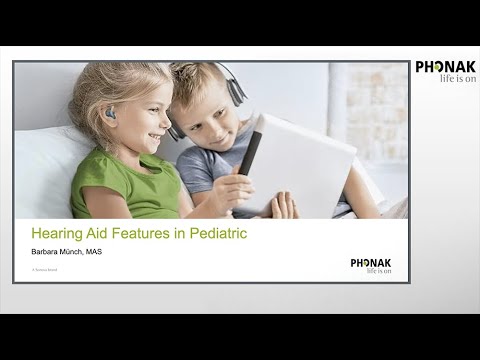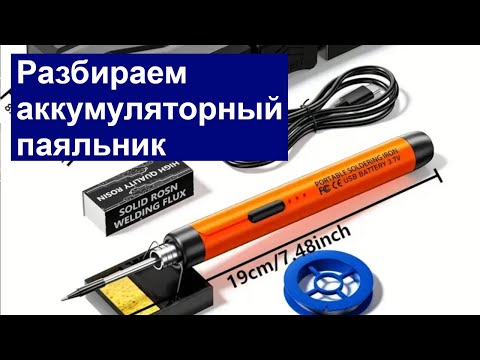Hearing Aid Features in Pediatric

Hello, everyone, and welcome to this presentation about hearing aid features in pediatric. My name is Barbara Muench and I'm a pediatric audiologist from Sonova. Fitting hearing aids to children is one of the biggest challenges a pediatric audiologist faces. Due to neonatal screenings we receive our youngest clients earlier than ever before. With our decisions for hearing aids we lay
the foundations and shape the future for the individual child. We have many responsibilities and duties. I believe that if we have the best possible technologies in our hands, this is a great starting point and a tremendous support in our job. The good news is: the technology is here. In this presentation,
I'd like to outline what the latest hearing instrument features can do for children. Before we're talking about features, let's first reflect what we want to achieve. If we think about children in general, not just kids with hearing loss, we know that they have many things to learn to help them succeed throughout their life. This isn't just learning how to read, how to write or how to do math. It's also the skills about building relationships which are hugely important to their ability to cope in the world. A recent paper from Harvard University examines the relationships of children with those around them during their early years. It showed that these relationships are fundamental in laying the foundation for a successful outcome in many areas. These areas include self-confidence,
mental health, learning motivation, achievement in school and later in life, successful conflict resolution, developing and sustaining positive relationships, just to name a few. So the question that then comes to mind is, how can we assist the children in developing these skills? According to Harvard University the answer to that question is serve and return interactions. What does serve and return mean? They are the back and forth interactions between the child and those around them in the early phases, the serve and returns will most likely be with a parent or close family members. They incorporate all communication strategies, whether they are words, gestures or body language. A prime example which could be extrapolated from this image is the baby vocalizing and banging her hands on the floor and the mother banging her hands on the floor and making a comment. That's a big noise, isn't it? And smiling, making eye contact and thus encouraging the baby to do it again, and in that way, driving the downstairs neighbors crazy. Well, research has shown that these serve and returns have
to provide the basis for important relationships by stimulating the formation of neural connections, strengthening the brain architecture, building those neural connections, and supporting the development of social and communication skills. Building on serve and returns, the quantity of words and the number of turns a child is exposed to up to the age of three years has a big influence on the activation of the language center. Interestingly, cognitive scientists from the Massachusetts Institute of Technology have found that the number of conversational turns between an adult and a child is even more critical to language development and has a stronger impact on brain activation than the number of words heard. When we think about quality, it can refer to both the complexity of the language used, as well as how well the child hears the words. In order to profit from all available serve and returns and assist the child's development, children with hearing loss need clarity and richness of sound, access to even more words and conversations, and finally hearing aids that they can and want to wear the full day and every day. Let me show how that
-looks like. -You can find love in a laugh. In a game of whispers. In solving a challenge together. Or simply in a good conversation. And sometimes love just needs a little help, the new Sky Marvel from Phonak helps children with hearing loss build relationships by providing access to back and forth conversations that are fundamental for growing strong bonds. Sky Marvel introduces a unique combination of pioneering technical innovations and essential child specific features, such as AutoSense Sky OS 3.0, the World's first Operating System designed for children. It automatically adapts
to their challenging listening environments. Sky Marvel is the world's first pediatric hearing aid, capable of direct streaming from both iOS and Android devices and Roger microphones opening up a world of communication opportunities. It's safe and robust even when life gets a little wet. Sky Marvel offers clear rich sound and access to more words every day, helping children with hearing loss build strong relationships. One conversation at a time. Phonak life is on. Sky Marvel has several advantages, clear, rich sound, it connects to smartphones, Roger microphones and more, it's rechargeable and has a child specific design. Let's have a look at each of these in more detail. A clear, rich sound is provided by Sky Marvel through AutoSense Sky OS 3.0, a dedicated pediatric
automatic system which includes classification of streamed signals thanks to multichannel directionality and the automatic noise program. Sky Marvel provides 24 percent better speech understanding in noise and finally with SoundRecover 2, which is a non-linear frequency compression, we are ensuring high frequency audibility. AutoSense Sky OS is the world's first operating system built specifically for a child's listening environment. A child's typical environment differs a lot from that of adults. It has been investigated how well AutoSense OS, the automatic for adults, classifies the child's day relative to an adult's day. The research found that some situations, such as group work
and yelling, are unique to children's daily listening environments and are not optimally recognized by AutoSense OS. This meant that they weren't being classified correctly and the pediatric operating system, the AutoSense Sky OS was developed. AutoSense Sky OS is 30 percent more precise in classifying a noisy classroom and thirty nine percent more accurate in recognizing yelling and shouting as an unwanted noise. This is now the automatic setting for all pediatric fittings. Between us: I also can imagine that some teachers with hearing loss could possibly benefit from this special automatic. They are exposed
to the same acoustical environment than the children. SoundRecover 2 is not a new feature. What we know about it is that it provides additional detection and recognition of high frequency speech sounds at the same time SoundRecover is maintaining low frequency structures, which is super important for speech acquisition. Let's take a look at how SoundRecover 2 works. SoundRecover 2
has an adaptive behavior which allows lowering to a much lower frequency than a non adaptive system. It will not disrupt important low frequency information like vowels. To achieve this, it switches between two starting points of compression or we call them cutoff frequencies depending on the ratio of energy in the input signal. If the ratio of energy in the input signal
is dominated by high frequencies, for example, a consonant like /s/, then no low frequency phoneme is present and compression is extended to the lower cutoff frequency CT1 If the ratio of energy in the input signal is dominated by low frequencies, for example a vowel like /a/ then compression only is applied in the area above the upper cutoff, the CT2. Let's see the animation: with the vowel /a/ the CT2 will be applied and with the high frequency /s/, we compress down to CT1. The area between CT1 and CT2 is called the adaptive area. Great to know that AutoSense Sky OS and SoundRecover 2 help us to provide a clear, rich sound for our children, isn't it? This is maximizing serve and return opportunities and increasing quantity and quality of words. And in a long term run, this will help to continue building those important social development skills. Sky Marvel is the world's first pediatric hearing aid that
provides direct streaming from both. iOS and Android devices, it's also the world's first pediatric hearing aid with direct streaming of Roger and kids can also enjoy direct streaming from multimedia sources through the TV connector. But why is that important? Kids today don't know a world without technology. Smart devices are an integral part of their daily lives for learning, socializing and for entertainment. In fact, recent research looking at media use
and attitudes found that 78 percent of elementary students report they regularly use a tablet or smartphone, and almost 80 percent of schools report using tablets in the classroom. For years, we have been working to ensure that children with hearing loss in the classroom have equal access to all these technologies. And now with Sky Marvel, they do. We know the proven benefits of remote microphone technology with significant improvement in speech understanding in noise and over distance compared to traditional FM. We also know from Benitez-Barrera and others
from Vanderbilt University that using Rocher at home can give children access to five thousand three hundred more words per day compared to using hearing aids alone. Further analysis of the data in that study has also shown that children could have access to as much as 12 percent more child directed speech. That's quality language input from a distance, thanks to Roger, that wouldn't be accessible with hearing aids alone. And lastly, new research shows that children using remote microphone technology at home perform better on higher order language skills. For example, they perform significantly better on receptive discourse compared to children who don't use Roger at home. Rocher provides better access to both quantity and quality of words and conversations. So how did we get this
information? Research conducted at Vanderbilt University, published in February twenty eighteen, shows some very interesting data regarding remote microphone use in the home setting. 10 families were observed over two consecutive weekends one weekend using the remote microphone and one without the remote microphone. A special technology, a language environmental analysis was used to measure the amount of talk by caregivers and the amount of care giver talk the child had access to. The first analysis showed that when using the remote microphones, children had access to approximately those five thousand three hundred more words per day. Here's the result of the second analysis.
The results show that on average, 57 percent of the talk that caregivers produced during a typical weekend at home was child directed speech, and 12 percent of child directed speech was produced from greater than six to 10 feet away from the child. This 12 percent of speech, produced at a relatively far distance from the child, reflects high quality adult talk that would likely only be heard by the child if using a remote microphone technology. Latest research from the study Outcomes of Children with hearing loss conducted by Curran at all and published in 2019, was looking into receptive discourse ability of children, using a personal remote microphone system at home. Twenty seven pairs of children were observed. The pairs differed only in remote microphone use at home. So one of the pairs had a remote microphone for use at home and the other didn't. The language performance at five years of age has been compared in terms of vocabulary, the expressive morphosyntax, means the word structure, and receptive and expressive discourse. And guess what? Children who received a personal remote
microphone system had significantly higher scores on receptive discourse ability than the control group. We now know about the most recent research available regarding remote microphone technology. However, we know that in the past it hasn't been easy to provide each child with a Roger system. Which receiver to use? A design-integrated receiver or the universal one with an audio shoe? How often did we lose the pins and how often did we forget to remove this stupid little sticker from the audio input? How to manage tamperproof battery does? I guess you know what I'm talking about. With Roger Direct a lot of those
considerations are gone. All we need to do is determine if there is a universal Roger X receiver already available. If yes, just check if it's a recent one, either champaign color or a newer serial number. And if this is the case, then it's a simple process to install the Roger X into the Sky Marvel hearing aid, nothing to remove or to attach just a quick and easy installation. If there isn't a Roger available, then the questions are slightly different. The decision is between the Roger X or an iN microphone with two installations included. What's better for the child? This depends on the educational set up
and should be discussed with the parents or caregivers. Once again, the receivers simply need to be installed once into the hearing aids. Roger Direct is not just the next step in the evolution of remote microphone technology. It's a revolution. The ability to wirelessly install a radio receiver into the hearing aid truly changes the everyday lives of the kids who need and use Roger the most. And in turn, with no pins, no compatibility to work out, no stickers and no lost receivers, it's easier than ever for professionals to provide these benefits to kids. So what does external receiver mean from the size perspective? Look at that, RogerDirect means that Sky Marvel, the one in the middle, is 42 percent smaller and 32 percent lighter compared to the Sky B devices with design integrated Roger receivers, which you see on the left side. And please keep in mind
that the majority of Rocher users are school age kids. Usually they even don't have the luxury of the Roger 18 or 19 receivers. Instead, they wear the solution on the right side. Hearing aid plus audio issue plus Roger receiver. What a difference in size. Smaller and lighter than ever, but 100 percent
Roger performance inside. And there's more, children can enjoy direct streaming from multimedia sources through the TV connector with direct streaming from all these different sources. It's even easier for children with hearing loss to access speech, information and entertainment from whatever multimedia sources. Another novelty are sky model rechargeable hearing aids, which are very well accepted by adults already and will also be a great solution for children. The rechargeable Sky Marvel provides children with a reliable power source that lasts all day and even includes 10 hours of streaming. A full charge is achieved in up to three hours of charging. There's a visible low battery warning and it's very easy to use.
Additionally, this is the perfect choice for our little listeners, with no battery door to open and no battery to find its way into curious little hands. Regarding safety, there are very robust tamperproof battery doors and hooks, and the indicator light has been positioned so that it's easier to see when the rocker switch is used. The color has also been changed when the hearing aid is in use. The LEDs are always green. When the battery is low, the indicators are rapidly flashing green for the M and red for the rechargeables. So Sky Marvel
is thought through in every detail. Sky Marvel is available in three form factors and in four performance levels, 90, 70, 50 and 30 level in order to provide a solution for every configuration of hearing loss and for different communication needs and age groups. Child specific design finally means much smaller and lighter hearing aids with RogerDirect, IP sixty eight rating for a high level of reliability, even when it gets a little bit of wet in the wild world of active kids, they are safe thanks to new tamperproof features and the new indicator light is clearly visible and informs parents and caregivers about the status of the hearing aid. There's also a pediatric sized Slimtube for small ears. Sky Marvel is crafted for kids and in many colors to ensure they can make the most of every serve and return. So you see, you've got the best technology in your hands. Now it's up to you. Your co-workers and the families: detect hearing
loss as early as possible. Fit according to state of the art pediatric feting protocols using verification and validation. Make sure the child is wearing and using its hearing solution consistently all day and motivate the parents to interact with their child as often as possible. With this, you can
ensure optimal speech and language development for each of your little patients. I wish you many successful hearing aid fittings and all the best for the children and their families. Thank you for listening. Phonak life is on.
2021-03-05 03:06


